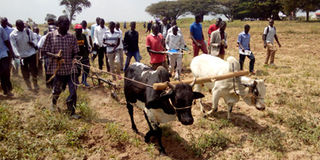Farmers thrilled by Farm Clinic

Nelson Ewadu (in green), animal traction expert demonstrates weeding technology. PHOTO BY Simon Emwamu.
What you need to know:
- The farmers treated to the eighth Farm Clinic, the first of its kind in eastern Uganda last Saturday, praised Nation Media Group, through its sister media houses, the Daily Monitor, NTV, KFM for the sacrifice geared at the betterment of the agricultural sector in the country, writes Simon Peter Emwamu
Treated to practical lectures in their hundreds on value chain addition, the farmers from across the region, and other parts of Uganda took home solid but practical information on modern farming techniques that if well utilised will triple the profit generating aspect in their farm ventures.
The Farm Clinic, held in Serere District, sponsored by Heifer International, the host agricultural institute, NaSARRI and NARO focused on a stretch of mix crop and animal husbandry, with crops such as cotton, citrus, sorghum, sunflower, groundnuts, peas, beef, dairy and cassava. Participants termed it a productive and enriching clinic and asked for more of the same if agribusiness in Uganda is to move to another level.
Emmanuel Opule, a citrus farmer from Pingire sub county, Serere District, overwhelmed by the practicability of the training, says the practical skills he acquired will enable him get rid of the rust mites, which have been a setback on the quality of citrus from his farm. “The rust mites have had vexing impact on my farm for more than three years, but with this lecture from the expert, I am armed, I will be able to rid my citrus venture of the rust mites very soon,” said Opule before adding, “After here we are retreating back to our farms much energised, knowing that the agronomists in this institutions can be consulted anytime free of charge, unlike before when we would shy away in ignorance about the free services offered here.” Jenifer Wadoli a groundnut farmer in Butaleja District, could not hold back her joy, after lectures on groundnut production, “This Farm Clinic has been so enterprising, I was able to see and know the processes of groundnut breeding, the best groundnut farm practices which guarantee high yields for maximisation of profits.” “With me also, I have been equipped with written literature on groundnuts, the contacts for the groundnut agronomists at NaSARRI, it’s a cut edge advantage for me against those who did not make it here,” she explained.
Experts
Experts took farmers through best farmer practices with emphasis on value chain practices, Tom Omara, an agronomist on root crop research at National Agricultural Research Organisation (NARO) with a bias in cassava research and multiplication said those who have long viewed the crop as staple food crop should make a shift turnaround in mind. “Cassava by its own right is a minefield, with a lot of demand to turnaround the welfare of a homestead in the shortest time possible,” he narrated.
The seasoned expert added that from food, confectionery, beer production, pharmaceuticals and furniture, the market for cassava products is real but insignificantly remains under dominance of few farmers who have seen the value in the crop. “Going into, cassava production and processing is not expensive,” Omara explained, adding “A simple cassava crater, drying racks and a simple grinding mill are fairly affordable for a determined farmer willing to have an edge in cassava production.” According to Omara, a capital of Shs10m is enough to invest in a complete set of stainless cassava processing unit.
Value addition
On value addition, the Namulonge based expert took farmers on how starch, white fine flour, cattle feeds and gari for porridge can be obtained from improved cassava plants. According to Omara, the processing can be done at 9-12 month of tuber maturity while emphasising that not all cassava varieties are suitable for value addition.
For best quality flour, Omara recommends Nase and NaroCas one varieties of cassava. “Mijera variety has a lot of fiber which in return gives bad quality flour and other confectionary products,” he explains. Omara added that the peeled tubers should always be washed clean, before they are crushed by the crater, and then sprayed at the drying racks before grinding into white fine flour ready for packaging in preferred quantities.
He said the starch which is used for bidding drugs by the pharmaceutical industries, is harvested in bigger processing factories.
Animal traction
Nelson Ewadu, the animal traction expert, told farmers that the animal traction weeding system saves about Shs300,000 per acre as opposed to the other ordinary weeding methods.
“The cost effectiveness of this animal traction weeding is it reduces the costs involved production,” he explained.
According to Ewadu, animal traction kind of weeding only works for crops planted in rows with spacing of 60centimeter by 60 or 90 by 90 centimeters, with crops such as maize, sorghum, simsim, cassava at its infancy stages of growth.




